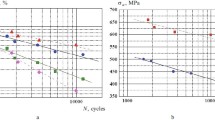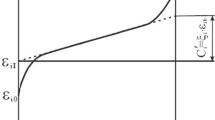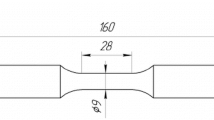Abstract
A comparison is made of the cyclic strength of 15Kh2NMFAA steel in three conditions, namely, normal, with increased brittleness, and with increased plasticity. Evaluation on the basis of the strain approach in the form of curves of the ranges of total strain Δεt vs the number of cycles until the occurrence of a crack Ni revealed different locations and slopes for different conditions of the steel. The energy criteria, namely, the energy of full deformation per cycle ΔWt and the total energy of full deformation Wt, have a generalized character and the experimental results form a common file for the three conditions of 15Kh2NMFAA steel.
Similar content being viewed by others
References
Standards for Strength Calculation for Atomic Power Station Equipment and Piping (PNAÉ G-7-002-86) [in Russian], Énergoatomizdat, Moscow (1989).
N. A. Makhutov, A. Z. Vorob'ev, M. M. Gadenin, et al., The Strength of Structures in Low-Cycle Loading [in Russian], Nauka, Moscow (1983).
V. P. Kogaev, N. A. Makhutov, and A. P. Gusenkov, Strength and Life Calculations of Machine Parts and Structures [in Russian], Mashinostroenie, Moscow (1985).
Feltner and Morrow, “The hysteresis energy of microplastic strain as a criterion of fatigue failure,” Tekh. Mekh., No. 1, 20–29 (1961).
G. R. Halford, “The energy required for fatigue,” J. Mater.,1, No. 1, 3–18 (1966).
V. M. Radhakrishnan, “An analysis of low cycle fatigue based on hysteresis energy,” Fatigue Eng. Mater. and Struct.,3, No. 1, 75–84 (1980).
A. Puškár and S. Golovin, Kumulácia Poskodenia v Procese Únavy, VEDA, Bratislava (1981).
V. Kliman and M. Bílý, “Hysterézna energia pri opakovanom zatazovani,” Kovové Materialy,4, No. 2, 508–518 (1982).
V. Kliman, “Determination of service life on the basis of the energy criterion,” The Mechanical Fatigue of Metals. Proceedings of the Sixth International Colloquium [in Russian], Naukova Dumka, Kiev (1983), pp. 104–109.
V. T. Troshchenko, Fatigue and Inelasticity of Metals [in Russian], Naukova Dumka, Kiev (1972).
Golos and Él'in, “A theory of accumulation of fatigue damages based on the criterion of specific energy of total strain,” Sovrem. Mashinostr., Ser. B, No. 1, 64–72 (1989).
A. G. Mazepa and V. A. Yukhanov, “The influence of contrasting heat treatment cycles on the cyclic properties of 15Kh2NMFAA steel,” Probl. Prochn., No. 10, 29–32 (1986).
Author information
Authors and Affiliations
Additional information
Translated from Problemy Prochnosti, No. 3, pp. 21–27, March, 1994.
Rights and permissions
About this article
Cite this article
Mazepa, A.G. A comparative evaluation of the cyclic strength of 15Kh2NMFAA steel on the basis of strain and energy approaches. Strength Mater 26, 181–186 (1994). https://doi.org/10.1007/BF02209392
Received:
Issue Date:
DOI: https://doi.org/10.1007/BF02209392




